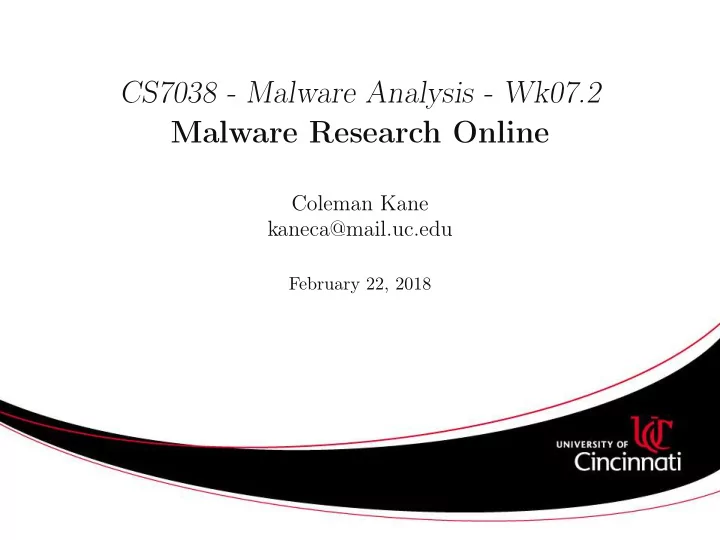

CS7038 - Malware Analysis - Wk07.2 Malware Research Online Coleman Kane kaneca@mail.uc.edu February 22, 2018 � �
Exploring the Online Ecosystem One nice aspect of malware analysis is that, since much of it originates online and primarily impacts users that rely upon the Internet, many of the communities doing malware research have established online presences. We will discuss various resources that exist online, and also take some time to dive deeper into what they have to offer. In some cases, you can get narratives describing attacks, while in other cases you can get documentation and reports discussing specific families of malware. Sometimes you can actually retrieve real malware artifacts as well. � �
Attack Descriptions Online A great resource, though not so user friendly, is the “APTnotes” repository hosted on GitHub. The content of the repository is a structured index of a large number of cyber intelligence reports going back to ˜ 2008. They’ve been archived in the author’s box.com account. https://github.com/aptnotes/ The ThreatMiner project offers a really nice searchable UI for this dataset: https://threatminer.org � �
OilRig Spearphish An attack that has been observed targeting Israel and other middle eastern countries. A report was published by ClearSkySec ( http://www. clearskysec.com ) earlier in 2017. https://github.com/aptnotes/data/issues/83 The adversary allegedly compromised the network of multiple IT services vendors, and used this access to send spearphishing emails to their targets. These emails contained a URL, similar to below, as well as a username and password. The message informed the recipient that the sender wanted their feedback in testing the system. It expressed urgency in the recipient getting back to the sender with feedback. https://______/dana-na/auth/url_default/welcome.cgi Look familiar? https://sslvpn.uc.edu/dana-na/auth/url_default/welcome.cgi In fact, they did an exemplary job of making a system that mimics a Juniper VPN login. � �
OilRig Fake VPN The adversary not only copied the HTML for the website, but also hosted a fake VPN client on it. In a traditional Web-based VPN software setup: 1. You will visit the webpage for your organization’s VPN 2. You use your credentials to log into the VPN 3. The Web-based application will perform some checks to determine if you have a VPN client installed 4. If not, you will be presented with the option to install one, by downloading and executing an installation program - typically expected to involve providing administrative rights to the installer In this example, rather than a legitimate Juniper VPN installer, the adversary offered a fake one that installs a backdoor on the system, instead of a VPN connection client. To the user, the behavior presents as expected. � �
Operation Double Tap, Suspect FireEye APT3 In this attack in 2014, a well known threat group known as APT3 to FireEye, is alleged to have sent a large amount of phishing attacks. Contrary to historic attacks from this adversary, this event was themed using a NSFW “spam-like” theme to deliver a backdoor. Earlier in 2014, the adversary has been alleged to have delivered malware via Facebook direct messaging. https://www.fireeye.com/blog/threat-research/2014/11/operation_doubletap.html https://www.fireeye.com/blog/threat-research/2014/06/clandestine-fox-part-deux.html This attack was novel for a number of reasons: Departure from historic themes that attempted to appear work-related • Attacks using social-media, non-email vector • New malware ( MyRat and MShell ) • � �
Operation Double Tap Attack In the Operation Double Tap attack, multiple malware layers were employed to achieve the objectives. 1. Spearphish email sent containing a link to sign up for entertainment service 2. Webpage at sign-in contains two malware vectors built in ( Trojan ): (a) VBscript built into the webpage to invoke an EXE downloaded from the website ( install.exe ) (b) An IE exploit that would work in versions of Windows prior to supporting powershell and would download and run install.exe 3. The install.exe writes two files to disk ( doc.exe and test.exe ) ( Dropper ) 4. install.exe executes doc.exe which attempts to escalate privilege and then runs test.exe � �
Operation Double Tap Attack (cont.) The test.exe program is a copy of the “MyRat” tool. Following the doc.exe execution, the test.exe program next attempts the following: Checks current user permission • Creates a “scheduled task”, like a UNIX cron job, to execute test.exe • on log in Constructs a command-and-control channel with a remote server • Upon behavioral analysis, its determined to be a backdoor . Further analysis, documented in the report, demonstrates that it has the following hard-coded behavior: Reads, Writes, Executes the files notepad.exe , notepad1.exe , • newnotepad.exe , notepad2.exe , note.txt in a Windows Temporary files folder � �
Operation Double Tap Classification Based upon the above discussion, we can apply the classification methods from last lecture to this attack: Familial The malware samples were identified as projects named “MyRat” and “MShell”. It appears likely that both of these were written by the same author or team of authors. Functional The attack utilizes some Trojan components, such as the initial website, as well as the install.exe delivered to the user. There is a backdoor test.exe . And there is also a dropper function in install.exe Behavioral The install.exe exhibits the behavior of writing files named doc.exe AND test.exe to disk. The file doc.exe exhibits the behavior of leveraging the CVE-2014-4113 exploit to escalate privileges. The test.exe program exhibits the behaviors of reading, writing, and executing files within a Windows temporary folder. � �
US Federal Indictments In late 2017, Chinese nationals alleged to be connected to the APT3 operation were indicted. Though this wasn’t delineated in the indictment, a number of security professionals who had been tracking this group connected the dots. Indictment: https://www.justice.gov/opa/pr/ us-charges-three-chinese-hackers-who-work-internet-security-firm-hacking-three-corporations Research: https://intrusiontruth.wordpress.com/2017/04/26/ who-is-behind-this-chinese-espionage-group-stealing-our-intellectual-property/ https://intrusiontruth.wordpress.com/2017/05/02/who-is-mr-wu/ https://intrusiontruth.wordpress.com/2017/05/05/who-is-mr-dong/ https://intrusiontruth.wordpress.com/2017/05/09/apt3-is-boyusec-a-chinese-intelligence-contractor/ http://freebeacon.com/national-security/ pentagon-links-chinese-cyber-security-firm-beijing-spy-service/ � �
Recommend
More recommend